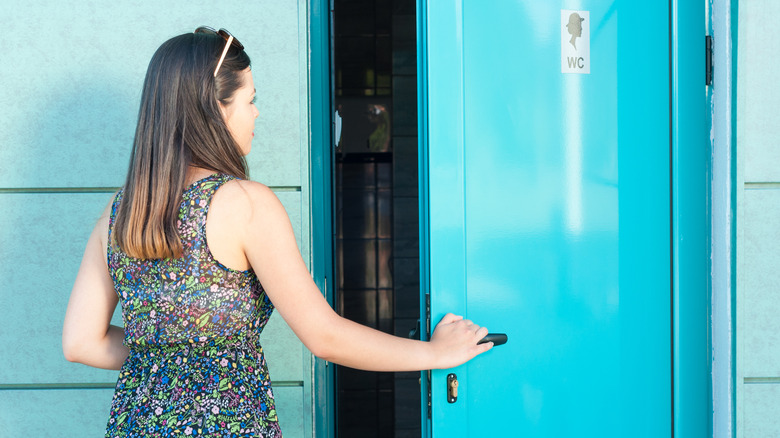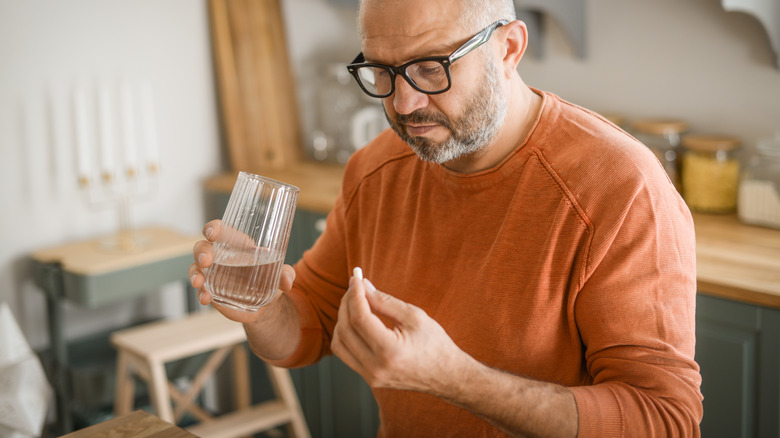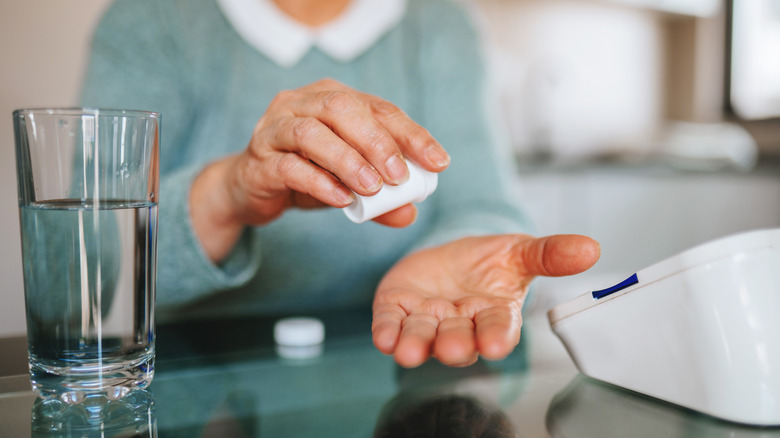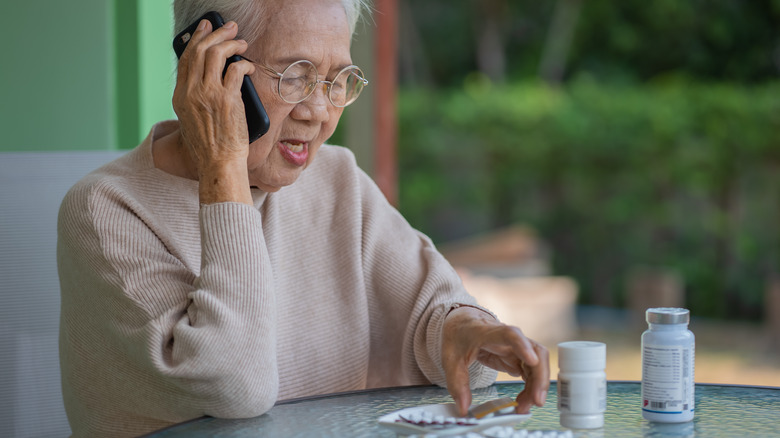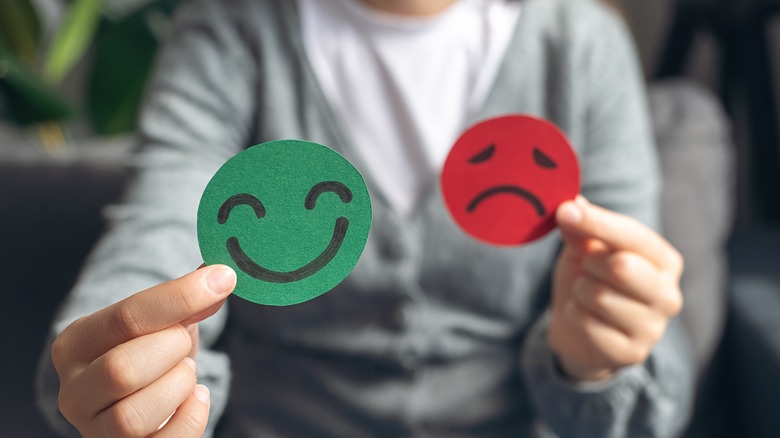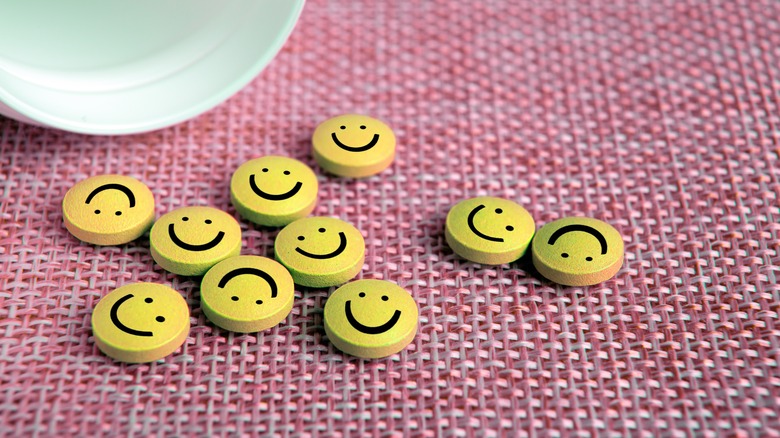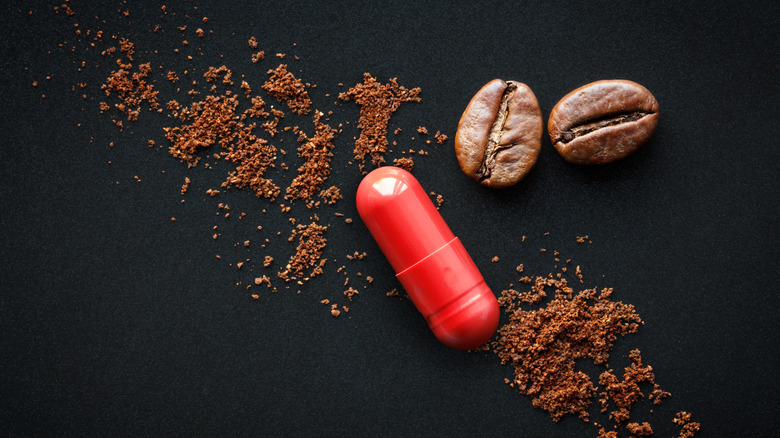Medications That May Actually Cause An Overactive Bladder
If you are peeing more than usual, you are one of the 33 million adults in the United States who have an overactive bladder (via Cleveland Clinic). This can be caused by a number of things, such as physical trauma to your abdomen, damage to the nerves that supply your bladder and its supporting structures, not having enough estrogen (especially after menopause), infection, obesity or being overweight, alcohol consumption, caffeine, and certain medications.
Although it is unclear exactly how people develop an overactive bladder, authors of a 2021 article published in Experimental and Therapeutic Medicine state that the main mechanism behind it is detrusor overactivity. The detrusor is a collection of smooth muscle fibers that make up the wall of the bladder. It stretches to hold as much urine as it can, and then contracts when it is time to pee. It is controlled by nerves that signal it to contract or relax, depending on a given situation (per StatPearls). In people who have an overactive bladder, their detrusor muscle is overactive, making it more sensitive to volume changes. This creates a sense of urgency to pee, even though the bladder is not yet full.
For medications specifically, there are several ways they can cause you to pee a lot more than usual. Some may make you more thirsty, causing you to drink more water and thus produce more urine, while others can interfere with the nerve signals that control your bladder. Below are examples of medications that can cause this.
Diuretics
There is a good reason why diuretics are called water pills. As explained by StatPearls, there are many classes of diuretics, with each class working slightly differently from one another. But in general, diuretics exert their action on the kidney tubules, a complicated structure controlled by enzymes and ion channels. The primary driving force of the kidneys is water and electrolyte balance. Diuretics alter this balance in such a way that makes the kidneys excrete more urine.
Diuretics are primarily used to treat conditions that cause your body to retain water, such as congestive heart failure (via Healthline). It is also effective in treating high blood pressure, because the less fluid you have in your body, the less pressure your blood exerts in your blood vessels. This, of course, can cause a variety of side effects. The more you pee, the less fluid you have in the body. Fluid is not just water; it contains important electrolytes as well. Diuretics can cause you to lose sodium and potassium, which in turn can cause you to develop headaches, dizziness, and muscle cramps. Diuretics can also make you dehydrated and feel more thirsty, trigger gout attacks, and cause diarrhea. In severe instances, some people may experience a severe allergic reaction, irregular heart rhythms, and/or kidney failure.
If you have a condition that is being treated with diuretics and you find that the side effects are too bothersome, speak with your healthcare provider about alternative options.
Other blood pressure medications
High blood pressure (i.e., hypertension) is one of the most common chronic conditions in the United States and throughout the world. According to the Centers for Disease Control and Prevention (CDC), close to half of adults in the US have high blood pressure, and only 25% of these adults have their blood pressure under control. Treatment usually involves a combination of taking medications and making lifestyle modifications.
Fortunately, there are many different types of medications that have been developed to help control blood pressure. Per the American Heart Association (AHA), these include alpha blockers, alpha-2 receptor agonists, ACE inhibitors, angiotensin II receptor blockers (ARBs), beta blockers, calcium channel blockers (CCBs), diuretics, and vasodilators. Each of these classes of drugs works differently from one another; some of them may work for some people, while others do not. Aside from diuretics, alpha-blockers, beta-blockers, and CCBs have been shown to cause increased urination as well.
Alpha blockers decrease blood pressure by dilating blood vessels. However, they can exert effects on the bladder as well and relax the muscles surrounding the bladder neck (via WebMD). This causes urine to flow out even when your bladder is not full. On the other hand, beta blockers and CCBs can block the contraction of your bladder muscles, which may lead to increased urination (per Drugs.com). Although it is still unclear how exactly this happens, studies have shown that people who are taking these medications experience an overactive bladder, especially at night.
Certain diabetes medications
Similar to blood pressure medications, there are also many drugs available to treat diabetes. Diabetes is also a leading cause of chronic illness, both in the United States and worldwide. It is estimated that 38% of adults in the U.S. have prediabetes, and as many as 37.3 million Americans (of all ages) have diabetes (per the CDC).
Among the many classes of diabetes medications, there is one that can cause you to pee more often than usual. SGLT2 (sodium-glucose transporter 2) inhibitors work exactly as their name suggests: They inhibit the transporter located in the kidneys that bring glucose into the body (via WebMD). In effect, glucose stays in the urine and gets excreted when you pee. This process reduces the amount of sugar in the body, which is the main problem in people with diabetes. Following this, it makes sense why one of the major side effects of taking SGLT2 inhibitors is urinary tract infections. Bacteria and yeast love sugar, and they can multiply and cause an infection in susceptible people. Other side effects include low blood pressure, an increased risk of fractures due to loss of bone density, and dehydration.
Examples of SGLT2 inhibitors include Farxiga, Jardiance, and Invokana. An added benefit to some of these drugs is that they have cardioprotective effects for people with chronic kidney disease and heart failure (per the National Kidney Foundation). If you are experiencing major side effects, however, speak with your doctor so that they can switch you to a different medication.
Antidepressants
Antidepressants are not only used to treat depression. They are also often prescribed for obsessive-compulsive disorder, generalized anxiety disorder, social anxiety, panic disorder, post-traumatic stress disorder, chronic pain, migraines, and insomnia (per StatPearls).
They are such a big class of drugs that some medications can also treat overactive bladder, while others can cause it. According to Mayo Clinic, the tricyclic antidepressant imipramine and the serotonin and norepinephrine reuptake inhibitor duloxetine are some of the treatment options for urinary incontinence. They can relax the bladder muscles to be able to hold more urine, while contracting the bladder neck muscles to prevent urine from leaking out. On the other hand, authors of a 2017 study published in the International Neurourology Journal found that certain antidepressants can worsen symptoms of overactive bladder. These include venlafaxine, escitalopram, paroxetine, fluoxetine, and sertraline.
If you are taking antidepressants, some of the common side effects to watch out for include nausea, vomiting, diarrhea, weight gain, drowsiness, and low libido (via MedlinePlus). Ironically, there is also a very small chance of having thoughts of suicide or self-harm for people 25 years old or younger who are taking antidepressants, especially at the very beginning of treatment or when their dose is changed. If you are experiencing any of these side effects, speak with your doctor so that they can safely wean you off of the medication and/or switch you over to a different one.
If you or someone you know needs help with mental health, please contact the Crisis Text Line by texting HOME to 741741, call the National Alliance on Mental Illness helpline at 1-800-950-NAMI (6264), or visit the National Institute of Mental Health website.
Mood stabilizers
Mood stabilizers are medications that treat conditions that can cause sudden shifts in mood, such as bipolar disorder, schizoaffective disorder, and certain personality disorders (via StatPearls). People with these conditions often have episodes where their moods shift between extremely high (i.e., mania) and extremely low (i.e., depression). Examples of mood stabilizers include lithium, valproic acid, and some anti-seizure medications (e.g., lamotrigine, carbamazepine).
Although it is still unclear how they work, mood stabilizers are thought to inhibit the uptake of a substance called inositol, which in turn can regulate how fast or how slow signals travel through neurons. Aside from wanting to pee more than usual, other common side effects of mood stabilizers include increased thirst, nausea, slurred speech, itching, hand tremors, irregular heartbeat, incoordination, changes in your vision, seizures, and blackouts (per Healthgrades).
According to Mind, it can be challenging to control mood disorders without the help of medications. If you are experiencing side effects from your medications, it would be a good idea to speak with your doctor so that they can find the right treatment for you. Most of the time, medications are combined with other treatment modalities such as talk therapy, joining support groups, and keeping a mood diary. It is also beneficial to take care of your physical health. Mental wellness is closely tied to a person's physical wellbeing, and you can take care of both by making sure you get good quality sleep, eat well, and exercise regularly.
Antipsychotics
Like antidepressants, antipsychotics have a misleading name. According to Cleveland Clinic, these drugs are used to treat not only psychosis-related conditions and symptoms (e.g., bipolar disorder, schizophrenia, delusional disorder, delirium), but also a variety of other conditions. These include Huntington's disease, Parkinson's disease, Tourette syndrome, and obsessive-compulsive disorder. Antipsychotics are generally classified as first-generation or second-generation. First-generation antipsychotics have more side effects and are very rarely used nowadays. Examples include haloperidol (Haldol) and loxapine (Adusuve). Examples of second-generation antipsychotics include brexpiprazole (Rexulti), lurasidone (Latuda), and aripiprazole (Abilify).
Incontinence (the inability to hold your urine or bowel movement) is a common side effect associated with antipsychotics. According to a 2021 review in Biomedicine & Pharmacotherapy, there is still no clear explanation as to how this happens. It is theorized that it may have something to do with the effect of antipsychotics on certain receptors that are present in the bladder, but it is also difficult to fully link incontinence to antipsychotics, because psychosis itself can lead to incontinence as well. Other side effects associated with antipsychotics include drowsiness, dizziness, nausea, vomiting, blurring of vision, low blood pressure, low libido, weight gain, dry mouth, and constipation (per PsychCentral).
The goal of treatment for psychosis and other related disorders is to choose the most effective medication with the fewest side effects. This can differ from one person to another. The National Institute of Mental Health (NIMH) adds that better outcomes have been observed in people who receive medications coupled with other forms of treatment such as therapy and family support.
Medications that contain caffeine
Coffee is not the only thing that contains caffeine. Caffeine can also be found in chocolate, tea, kola nuts, the guarana plant, energy drinks, some chewing gum brands, and certain medications. If you are one of the many people who drink coffee on a regular basis, you probably drink it to help keep yourself awake and alert throughout the day, or you drink it first thing in the morning to help jumpstart your day. Surprisingly, caffeine is also used to help manage many forms of headaches, and it is also suspected to be effective in managing several other conditions like asthma, diabetes, gallbladder disease, pain, and Parkinson's disease in conjunction with other medications. Although it is relatively safe to consume caffeine, it is not without side effects. There are also dangers associated with taking too much. Common side effects include nausea, vomiting, stomach irritation, rapid heartbeat, jitteriness, and insomnia (via RxList).
According to Healthline, caffeine is a diuretic, which means that it causes your body to produce more urine. In addition to this, caffeine may also irritate the lining of the bladder, causing it to spasm and make you pee more often. Examples of medications that contain caffeine include Excedrin, Pamprin, Midol, Levacet, Fioricet, Norgesic, and many more. If you are experiencing overactive bladder symptoms, it may be a good idea to cut back on caffeinated drinks. And when you are buying over-the-counter medications, make sure to check the ingredient list first and try to avoid ones that have caffeine in them.

